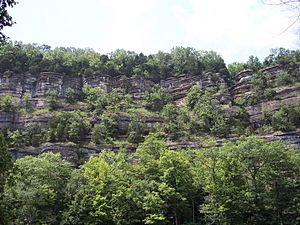Kentucky River Palisades facts for kids
The Kentucky River Palisades are amazing steep cliffs and rocky areas made of limestone. They stretch for about 100 miles (160 km) along the Kentucky River in the middle of Kentucky, United States. These tall cliffs create beautiful gorges and are a special part of the landscape.
Contents
How the Palisades Formed: Geology
The Kentucky River Palisades are like a deep, cliff-lined path carved by a river. The river originally flowed in wide, winding loops on a flat area called the Lexington Peneplain.
River Erosion and Rock Layers
Over a very long time, as sea levels dropped, the river started to cut deeper into the ground. It carved its way through layers of rock that formed millions of years ago. These rocks include limestone, shale, and dolomite.
Most of the area is covered by Lexington Limestone. This rock usually forms gentle slopes when it erodes. However, the Kentucky River Fault system played a big role here. A fault is like a giant crack in the Earth's crust where rocks have moved. Along this fault, one side of the land was pushed up several hundred feet higher than the other.
Strong Rocks Create Cliffs
Below the Lexington Limestone are very strong layers of dolomite and limestone. These are called the High Bridge Group rocks. They are much harder to erode. When the river cut down to these tough rocks, it couldn't easily carve wide valleys. Instead, it formed the tall, winding cliffs we see today.
Did you know? Daniel Boone's famous Fort Boonesborough was built near the fault and the eastern end of these cliffs!
Wildlife and Plants: Ecology
Many environmentalists believe the Palisades are a truly special ecosystem. This means they have a unique mix of land, soil, and plants that are different from the flat areas around them.
Special Plants and Flowers
In spring, the Palisades are covered in beautiful wildflowers. These flowers bloom for a short time and are especially bright because of the rich limestone soil.
Home to Rare Animals
The deep cliffs provide a safe home for four different species of endangered bats. Many rare and endangered plant species also live here. The steep cliffs have the largest amount of forest in the Inner Bluegrass area. Most other parts of the Inner Bluegrass have been developed or cleared.
Trees of the Palisades
On the steep limestone slopes, you'll find many blue ash trees, chinquapin oaks, and sugar maples. Other less common trees grow here too, like rock elm, yellowwood, and yellow buckeye.
Some areas on old sandy river terraces and ridges have more acidic or less fertile soil. Here, you might see beech and tulip poplar trees. These trees are more common in Appalachian Kentucky. Other unique plants found in the Palisades include Paxistima, chokecherry, and different kinds of Viburnums.
Protecting the Palisades: Nature Preserves
Several special areas, called nature preserves, help protect the Kentucky River Palisades. These places allow people to enjoy and learn about this unique environment.
- Clyde E. Buckley Wildlife Sanctuary
- Crutcher and Sally Brown
- Floracliff (you can visit with a guided hike)
- Jim Beam
- Dupree
- Lower Howard's Creek
- Raven Run
- Tom Dorman State Nature Preserve
In 2007, the Kentucky State Parks bought 90 acres (about 364,000 square meters) of land next to Tom Dorman State Nature Preserve. This land was bought to create a new Palisades State Park, which will help protect even more of this amazing area.
Images for kids







